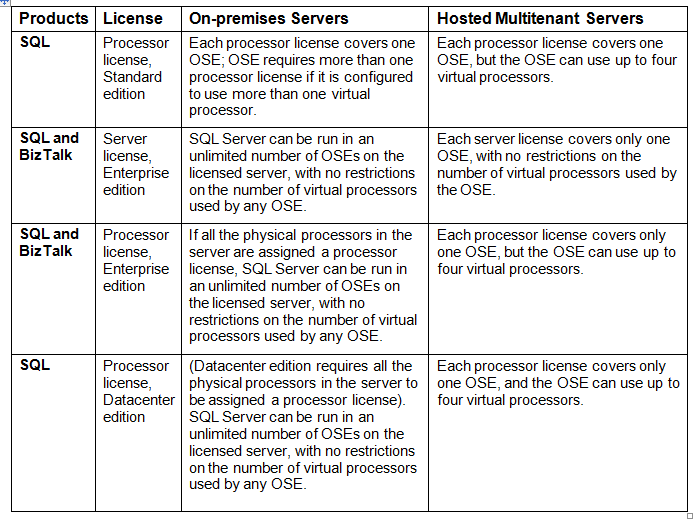Reading the fine print on Microsoft's new 'cloud-ready' licensing terms

As of July 1, Microsoft introduced new licensing mobility terms into the company's volume license agreements. Microsoft's stated goal in making the changes was to enable customers to easier for customers to move their application-server workloads from on-premises to the cloud and/or to run hybrid cloud/on-premises set-ups.
Directions on Microsoft, the Kirkland, Wash.-based Microsoft-watching firm, combed through the fine print and published a report entitled "Enterprise Cloud Licensing Rules Clarified" on some of the new restrictions and caveats.
Directions analyst John Cullen -- who spent the last five years at Microsoft writing the licensing rules for Windows Server before joining the firm -- is the author of the report. I had a chance to ask him about some of his findings. Here is our exchange;
MJF: What's your take as to why Microsoft is making these changes (in terms of benefits to customers, partners and to the company itself)?
Cullen: This is to make it more attractive and easier for customers with Software Assurance to migrate to the cloud; specifically to the hoster’s third party cloud. It is also a clear Microsoft attempt to make sure SA maintains its relevancy with the move to cloud computing. Microsoft wants to further enable customers moving to the cloud; whether it’s on Microsoft’s hosted online services; or through a third party hoster under SPLA (Service Provider License Agreement). It also provides more value to the Software Assurance subscription program. MJF: What do you anticipate the net effect of these changes will be? Are they going to be more positive or more negative for most customers? And positive or negative for the 3rd party hosters? Cullen: Overall, these changes create a net positive effect because the customer can now do something that they couldn’t do before, and Microsoft is not taking away any existing license rights. These changes provide added flexibility for customers to move licenses to third party hoster clouds that are multitenant (i.e., hardware shared across multiple customers). The hoster can charge less money to end customer and still make more money since customers are now bringing their own licenses. However, the hoster will have a more complicated internal process for tracking license compliance with the new rules.
MJF: Do you expect customer costs to go up, down or stay about the same as a result of these changes (and will different customer segments experience different effects)?
Cullen: This gets complicated because it depends on a license cost comparison between the overall costs when customer had to pay hoster for SPLA licensing fees versus the costs of on-premises licenses and SA that are moved to a hoster. Generally, I expect these changes can reduce licensing costs in many scenarios, but as highlighted, there can be cases when moving licenses to a hoster would require additional purchases to be compliant.
MJF: What types of customers are likely most affected by the reduction in the number of operating system environments (OSEs) allowed under license mobility?
Cullen: The most affected will likely be customers moving processor licenses for SQL Server Enterprise and Datacenter editions.
A scenario where you “win” (licenses let you do more in the cloud than on-premises): Were running one SQL Server workload on a dual proc on-premises server licensed with two SQL Enterprise proc licenses. You can move the workload up to a multitenant hoster with a quad proc box, at times using more proc “horsepower” than you did when on premises, and yet you only need to allocate ONE of your two SQL Enterprise proc licenses to do so.
A scenario where you “lose” (you’ll need to supplement with more licenses when you move to the cloud): Were running four SQL Server workloads, each in its own VM, on a dual proc on-premises server licensed with two SQL Server Enterprise proc licenses. Moving these licenses to the cloud would entitle you to run only two of the four workloads on the hoster’s multitenant server.
MJF: Any particular “gotchas” worth pulling out from the report? In other words, should BizTalk users be especially wary? Or SQL Server customers? (and if so, why) Cullen: The primary "gotcha" from our report would be concerning SQL Server and BizTalk server and processor licenses. Here is an abbreviated chart showing how the use rights become more limiting when the licenses are moved to hosted multitenant servers of a hoster:
(click on the chart above to enlarge)
This chart lists server application licenses and key differences between their on-premises licensing use rights and corresponding licensing use rights when moved to multitenant servers hosted by a service provider hoster. Depending on the product, the results of moving a license to the cloud can vary significantly.
Note that the term "virtual processor" used in the chart has a specific meaning for purposes of licensing. A virtual processor, for purposes of licensing, is the equivalent of one physical processor's worth of computational power (with a physical processor defined as a chip occupying a socket on the motherboard), which is a very different definition than the industry-accepted technical definition of virtual processor. As stated in Microsoft's quarterly Product Use Rights (PUR) document, "Solely for licensing purposes, a virtual processor is considered to have the same number of threads and cores as each physical processor on the underlying physical hardware system."
Directions holds regular Microsoft Licensing Boot Camps, the next of which is slated for Orlando from October 25-26.
